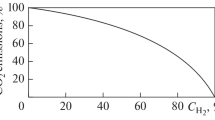Abstract
The results of the reconstruction of an E-500-13.8-560 KDT (TPE-430) boiler performed to reduce nitrogen oxide (NOx) emissions are discussed. In this case, a NOx concentration of 119 mg/m3 has been reached only by using new burner devices. It has been demonstrated that the applicable environmental legislation contains a set of measures having a considerable effect on the current and planned business activities of the thermal power industry and power machine building enterprises. A brief description of the boiler is presented. Challenging issues of its operation are considered, and the operating and investment expenditures are analyzed. The thermal design of the boiler is assessed. The available burner devices with ultralow emissions are considered, and their best option has been selected. It has been demonstrated that successful implementation of the project requires special engineering activities to be performed before replacing the burners in the boilers to optimize the design and parameters of the air path. To construct a model of the air path, on-site studies of the air ducts of the TPE-430 boiler were carried out. On the basis of the obtained data, a physical model of the air path was made of plexiglass air. It was blown with cold air whose flow was visualized using helium soap microbubbles. The results of the physical simulation were used to arrange the annular ducts from the manifold to the new burners and to determine location and size of structural members to be installed in air ducts and burner boxes to achieve the required uniformity of the air flow.








Similar content being viewed by others
Notes
The boilers are classified by the characteristics of the active combustion zone into seven groups for the selection of measures for environmental protection.
Unfortunately, all GOSTs that comply with the Law on Technical Regulation no. 184-FZ are voluntary or advisory in nature. “Standard values” are set as “process indicators” in the Information-and-Engineering Handbook ITS 38-2017; however, when this paper was prepared, they had not yet been approved by the order of the Ministry of Natural Resources of the Russian Federation.
REFERENCES
The Passport of the National Project “Ecology”, Approved by the Presidium of the Council under the President of the Russian Federation for Strategic Development and National Projects (Protocol No. 16 of December 24, 2018). https://www.mnr.gov.ru
ITS 38-2017. Fuel Combustion on Large Plants for Production of Energy (Byuro NDT, Moscow, 2017). https://www.gost.ru
V. M. Parchevskii, “Ecological and economic assessment of technological methods for reducing nitrogen oxide emissions,” Teploenergetika, No. 1, 13–17 (1993).
V. E. Mikhailov, M. I. Saparov, N. A. Zroichikov, D. R. Grigor’ev, N. S. Shestakov, N. S. Klepikov, A. E. Leikam, A. M. Rokachevskii, A. Yu. Nedre, and A. N. Vivchar, “The relevance of the development and implementation of low-emission burners of a new generation, providing modern and future requirements for emissions of nitrogen oxides in power boilers,” Ekol. Mashinostr., No. 3, 56–63 (2019).
I. L. Ionkin, P. V. Roslyakov, and L. E. Egorova, “Classifying gas/fuel-oil-fired boilers by the characteristics of the active combustion zone for selecting air-pollution control measures,” Therm. Eng. 47, 76–82 (2000).
1999 Gothenburg Protocol to Abate Acidification, Eutrophication and Ground-Level Ozone. https://www.un.org/ ru/documents/decl_conv/conventions/pdf/abate.pdf
Thermal Calculation of Boilers (Normative Method), 3rd ed. (Tsentr. Kotlo-Turbinnyi Inst., St. Petersburg, 1998).
Rule 4320. Advanced Emission Reduction Options for Boilers, Steam Generators, and Process Heaters Greater than 5.0 MMBtu/hr (Adopted October 16, 2008; Amended December 17, 2020). https://www.valleyair. org/rules/currntrules/r4320.pdf
N. A. Zroichikov, D. V. Shpakov, A. O. Nikulin, and V. R. Kotler, “Solution of the nitrogen oxides emission problem in the state of California (USA),” Energ. Rubezhom, No. 6, 44–47 (2018).
GOST 50831-95. Boiler Plants. Heat-Mechanical Equipment. General Technical Requirements (1997).
Author information
Authors and Affiliations
Corresponding authors
Additional information
Translated by T. Krasnoshchekova
Rights and permissions
About this article
Cite this article
Zroychikov, N.A., Grigoriev, D.R., Gamburg, M. et al. Introduction of Burners with In-Furnace Flue Gas Recirculation at a Power Boiler. Therm. Eng. 68, 865–872 (2021). https://doi.org/10.1134/S0040601521110082
Received:
Revised:
Accepted:
Published:
Issue Date:
DOI: https://doi.org/10.1134/S0040601521110082



